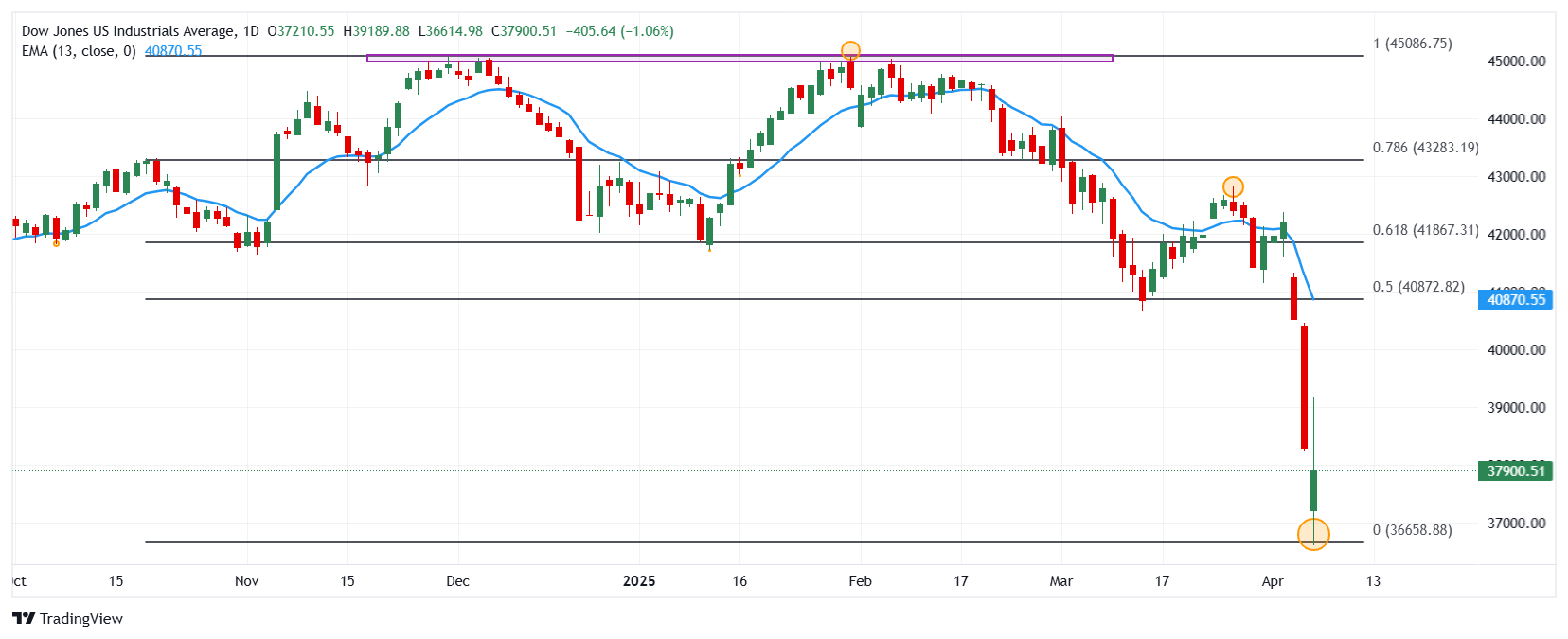- The Dow Jones loses 1.16% daily, operating currently over 37,865.
- The Nasdaq 100 wins 0.10% in the day, after reaching minimums not seen since January 8, 2024.
- The S&P 500 loses 0.05% on Monday, spinning three consecutive days with losses.
- Donald Trump urged China to withdraw the 34% tariff to American goods. In case of not being carried out, the US administration will impose additional tariffs of 50% to China.
The Dow Jones established a maximum of the day in 39,189, where he found aggressive vendors that led the index to minimal not seen since December 13, 2023 in 36,614.
The Dow Jones industrial average began operating in 37,210, while the Nasdaq 100 technological index began negotiations in 17,207. The S&P 500 opened in 4,964, reaching minimum not seen since January 19, 2024.
Nike and Apple keep Dow Jones in negative territory
The Dow Jones index falls 1.16% today, losing 165 points on the first day of the week, quoting when writing about 37,865.
Nike (NKE) shares lead the losses in Dow Jones, by going back 4.10% daily, currently operating at $ 55.05, staying within the operational range of Friday’s session.
In the same tune, Apple (AAPL) values have a fall of 3.45% on Monday, reaching minimums not seen since May 3, 2024 in 174.62 $.
The Dow Jones maintains the bassist perspective, signing its third consecutive day down, in tune with the main stock market rates.
The Nasdaq 100 reacts upwards after reaching minimum of 15 months
The Nasdaq 100 technological index rises 0.10% today, ending with a streak of two consecutive days with losses, currently quoting over 17,405.
APPLOVIN CORPORATION titles (app) rebound 8.77% daily, reaching maximum of April 3 in 253.61 $, leading profits in Nasdaq 100.
On the other hand, Microchip Technology (MCHP) shares react up to April 6, 2020 in 34.13 $, winning 7.26% on Monday, consolidating within Friday’s operational range.
Volatility in financial markets persists in the midst of commercial tensions caused by Donald Trump’s tariff rhetoric. In this sense, the Nasdaq 100 wins 55 points, ending with a streak of two consecutive days with losses, bouncing from minimums not seen since January 8, 2024 in 16,347.
The S&P 500 remains in negative terrain in the midst of commercial tensions
The president of the United States, Donald Trump, has increased commercial tensions by warning of China on an increase in an additional 50% tariff in case of not withdrawing the 34% rates imposed on the original goods of the US.
After this news, the S&P 500 decoced 0.22% in the day, reaching minimum not seen since January 19, 2024 in 4,810.
Stanley Black & Decker shares (SWK) sink 5.87%, staying within the operational range of Friday’s session at 59.07 $.
The look of investors focuses on the publication of the FOMC minutes and the consumer price index to be released on Wednesday and Thursday, respectively.
Technical Analysis of Dow Jones
The Dow Jones established a short -term resistance given by the maximum of March 26 in 42,820. The next key resistance is observed at 45,068, maximum of January 31. Down, the key support is located at 35,953, a pivot point of December 8, 2023.
Dow Jones daily graphics

Dow Jones Faqs
The Dow Jones Industrial Avenge, one of the oldest stock market indexes in the world, consists of the 30 most negotiated values in the United States. The index is weighted by the price instead of capitalization. It is calculated by adding the prices of the values that compose it and dividing them by a factor, currently 0.152. The index was founded by Charles Dow, also founder of the Wall Street Journal. In recent years it has been criticized for not being sufficiently representative, since it only follows 30 companies, unlike broader rates such as S&P 500.
There are many factors that promote the Dow Jones Industrial Average (DJIA) index. The main one is the added performance of the companies that compose it, revealed in the quarterly reports of business benefits. The American and world macroeconomic data also contribute, since they influence investor confidence. The level of interest rates, set by the Federal Reserve (FED), also influences the DJia, since it affects the cost of credit, on which many companies depend largely. Therefore, inflation can be a determining factor, as well as other parameters that influence the decisions of the Federal Reserve.
Dow’s theory is a method to identify the main trend of the stock market developed by Charles Dow. A key step is to compare the direction of the Dow Jones Industrial Avenge (DJIA) and the Dow Jones Transportation Average (DJTA) and just follow the trends in which both move in the same direction. The volume is a confirmation criterion. The theory uses elements of maximum and minimum analysis. Dow’s theory raises three phases of the trend: accumulation, when intelligent money begins to buy or sell; Public participation, when the general public joins the trend; and distribution, when intelligent money abandons the trend.
There are several ways to operate with the DJ. One of them is to use ETF that allow investors to negotiate the DJ as a single value, instead of having to buy shares of the 30 companies that compose it. An outstanding example is the SPDR Dow Jones Industrial Avenge ETF (day). Future contracts on the DJ allow the specular operators about the future value of the index and the options provide the right, but not the obligation, to buy or sell the index at a predetermined price in the future. Investment funds allow investors to buy a part of a diversified portfolio of DJ values, which provides exposure to global index.
Source: Fx Street
I am Joshua Winder, a senior-level journalist and editor at World Stock Market. I specialize in covering news related to the stock market and economic trends. With more than 8 years of experience in this field, I have become an expert in financial reporting.







